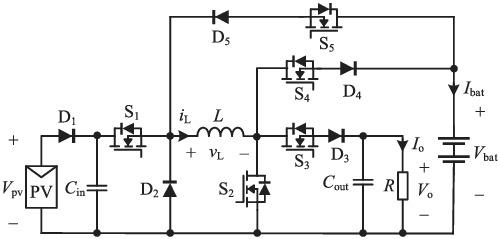当前位置:
X-MOL 学术
›
Int. J. Circ. Theory Appl.
›
论文详情
Our official English website, www.x-mol.net, welcomes your
feedback! (Note: you will need to create a separate account there.)
Analysis, control, and modeling of the three-port converter without port voltage constraint for photovoltaic/battery system application
International Journal of Circuit Theory and Applications ( IF 1.8 ) Pub Date : 2021-04-28 , DOI: 10.1002/cta.3043 Qingxin Tian 1 , Guohua Zhou 1 , Minrui Leng 1 , Guodong Xu 1 , Xianyan Fan 1 , Tiesheng Yan 2
International Journal of Circuit Theory and Applications ( IF 1.8 ) Pub Date : 2021-04-28 , DOI: 10.1002/cta.3043 Qingxin Tian 1 , Guohua Zhou 1 , Minrui Leng 1 , Guodong Xu 1 , Xianyan Fan 1 , Tiesheng Yan 2
Affiliation

|
For a photovoltaic (PV)/battery power system consisting of PV module, energy storage system, and local load, using a three-port converter (TPC) instead of several single-input converters is more desirable, such as simpler circuit, higher efficiency, lower cost, and centralized control without communication circuit. In this paper, a TPC is proposed and analyzed, which includes operating modes, steady-state performance, and parameter design. Compared with other converters, the proposed TPC has a low cost, compact structure, and a more flexible voltage relationship among all ports. Moreover, energy management and control methods are further proposed for PV/battery systems based on the proposed converter, which can achieve maximum power point tracking (MPPT) of PV module and constant output voltage. In order to design the control loop and realize multivariable optimal control, a small-signal model of the converter is obtained in each operation mode. Then a detailed decoupling design approach based on a small-signal model is provided to allow a separate controller design for the proposed converter. Finally, the validity of the proposed converter and its energy management and control method are verified by experimental results.
中文翻译:

用于光伏/电池系统应用的无端口电压约束的三端口转换器的分析、控制和建模
对于由光伏组件、储能系统和本地负载组成的光伏(PV)/电池电源系统,使用三端口转换器(TPC)代替多个单输入转换器是更可取的,例如电路更简单,效率更高,成本低,集中控制,无需通讯电路。在本文中,提出并分析了一种 TPC,它包括工作模式、稳态性能和参数设计。与其他转换器相比,所提出的 TPC 成本低,结构紧凑,所有端口之间的电压关系更灵活。此外,基于所提出的转换器,进一步提出了光伏/电池系统的能量管理和控制方法,可以实现光伏组件的最大功率点跟踪(MPPT)和恒定输出电压。为了设计控制回路,实现多变量优化控制,获得了变换器在每种工作模式下的小信号模型。然后提供了基于小信号模型的详细解耦设计方法,以允许针对所建议的转换器进行单独的控制器设计。最后,通过实验结果验证了所提出的转换器及其能量管理和控制方法的有效性。
更新日期:2021-04-28
中文翻译:

用于光伏/电池系统应用的无端口电压约束的三端口转换器的分析、控制和建模
对于由光伏组件、储能系统和本地负载组成的光伏(PV)/电池电源系统,使用三端口转换器(TPC)代替多个单输入转换器是更可取的,例如电路更简单,效率更高,成本低,集中控制,无需通讯电路。在本文中,提出并分析了一种 TPC,它包括工作模式、稳态性能和参数设计。与其他转换器相比,所提出的 TPC 成本低,结构紧凑,所有端口之间的电压关系更灵活。此外,基于所提出的转换器,进一步提出了光伏/电池系统的能量管理和控制方法,可以实现光伏组件的最大功率点跟踪(MPPT)和恒定输出电压。为了设计控制回路,实现多变量优化控制,获得了变换器在每种工作模式下的小信号模型。然后提供了基于小信号模型的详细解耦设计方法,以允许针对所建议的转换器进行单独的控制器设计。最后,通过实验结果验证了所提出的转换器及其能量管理和控制方法的有效性。











































 京公网安备 11010802027423号
京公网安备 11010802027423号